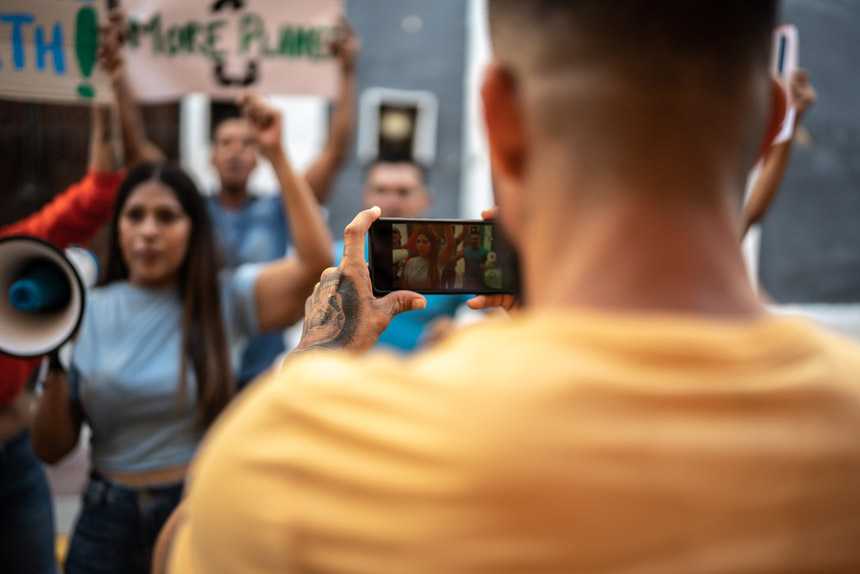

At its core, social justice embodies the belief that every member of a society is entitled to equal rights and opportunities. This foundational principle is grounded in the empowerment of individuals and fosters active participation that allows them to shape decisions affecting their lives. Social justice activism, as an extension of these principles, safeguards the voices of the marginalised and vulnerable and ensures that they are not subjugated by those with greater influence.
The Influence of Social Media on Social Justice Activism
A linchpin of modern communication, social media is increasingly impacting how ideas are disseminated and opinions formed. Nevertheless, its role in social justice activism introduces a complex dynamic that prompts us to assess whether social media acts as a catalyst for positive change or does it potentially exacerbate existing disparities.
The Dual Nature of Social Media’s Impact
- The Power of Citizen Journalism: One of the strengths of social media in the realm of social justice activism lies in its ability to facilitate citizen journalism and give voice to the voiceless. This becomes particularly crucial in areas where media freedom faces significant challenges. Through social media platforms, individuals can act as witnesses and provide first-hand accounts of events and injustices that might have otherwise gone unreported and unrecognised.
- The Dangers of Disinformation: The same platform that enables citizen journalism also opens the door to the spread of disinformation. False narratives and sensationalised news stories can quickly gain traction to muddy the waters of genuine social justice causes. In this age of information overload, discerning truth from falsehood has become increasingly challenging.
Case Studies: Examining Social Media’s Impact on Social Justice
Examples of two campaigns within the same region illustrate the contrast of how social media shapes the trajectory of social justice activism. One exemplifies how social media has propelled campaign objectives by overcoming disinformation hurdles, while the other underscores where social media fell short in leveraging its potential to advance the cause.
Indian Farmers’ Protest
In June 2020, the Central Government of India introduced three agricultural reform bills with the primary objective of facilitating the privatization of the agricultural market and modernizing India’s farming practices. Proponents believed the laissez-faire laws would lead to increased investment and provide farmers with flexibility. However, critics voiced apprehensions about the elimination of already weak state protections, fearing potential exploitation of farmers.
India’s agricultural policy framework, which was developed in the 1960s during the Green Revolution to ensure food security, initially transformed agricultural practices by introducing high-yield varieties of wheat and rice seedlings. This optimization of crop productivity played a crucial role in alleviating poverty (Nelson, 2019). However, these policies have now become outdated and resulted in stagnant growth. While there is a consensus that these policies should be updated, challenges include a lack of trust, and the absence of farmer voices in shaping laws that impact their livelihoods.
Voiceless Represenation
More than half of India’s workforce engages in farming, a crucial sector that supports approximately 70% of rural Indian households. Unfortunately, the distressing issue of suicides within agricultural communities has persisted in India since the 1970s. An estimated 400,000 farmers took their own lives between 1995 and 2018, averaging about 48 suicides a day. Farmers have had to contend with an escalating debt crisis further exacerbated by the challenges posed by the climate crisis.
Indian farmers have also grappled with an increasing marginalization across social, economic, cultural and political realms leading to an erosion in both political negotiating power and meaningful representation in government initiatives designed for their welfare. This mounting frustration culminated in a wave of protests of an unprecedented scale and duration.
The end of 2020 marked a crucial turning point in the ongoing struggle of Indian farmers, resulting in a protest quite unlike those in preceding years in terms of persistence and size. This shift influenced by the introduction of social media as a campaign tool not only fortified the mission to repeal the agricultural reform bills, but also empowered farmers to seize control of their narrative, shielding them against a barrage of disinformation both for and against their cause.
Social Media Campaign
The campaign utilized Facebook for live streams to share their narrative. The page gained so much attention that it was initially taken down but eventually restored. The increased attention from social media not only garnered more support, but it also brought about additional challenges, including blocked mobile internet services. Additionally, there were requests made to Twitter, now known as X, to remove posts featuring specific hashtags associated with the protests.
Other social media platforms, including Twitter, Instagram, Snapchat and YouTube, also played a significant role in amplifying the farmers’ message. Notably, Twitter emerged as a key player in attracting international attention. Noteworthy individuals and organizations, such as UN Human Rights Office, respectively, contributed to the campaign’s success by sharing messages on Twitter. Domestic influencers, including journalists and activists, further disseminated these messages.
Central to the campaign’s strategy was the use of the hashtag #FarmersProtests, which effectively magnified its message both domestically and internationally. This approach significantly heightened the campaign’s visibility and impact, thereby capturing the attention of news outlets, influencers and policymakers who actively monitored and engaged with the content associated with the hashtag.
While the journey towards social justice for farmers in India remains ongoing, the campaign achieved its initial short-term goals with notable success. After a year of persistent protests, the government took a decisive step by choosing to repeal the farm laws.
Dalit Lives Matter (2020)
Interestingly, there are instances where social media has fallen short in its pursuit of social justice. Analyses of campaigns where online activism did not materialize into tangible real-world impact offer invaluable insights. The impactful role of social media in the Farmers Protest is in sharp contrast with its minimal influence on the Dalit Lives Matter issue. This may help elucidate the limitations of social media and guide the development of more effective strategies for advocacy and mobilization, especially in view of regional differences and variability.
Voiceless Representation
Dalits are a systematically marginalized social group who face discrimination and violence in South Asia. Dalits were previously known as the ‘untouchables,’ and despite the legal abolition of untouchability in 1950 when India transitioned to a republic, this deeply ingrained societal ill persists in the collective psyche of the nation. According to Minority Rights Group International, there are currently some 166.6 million Dalits in India. However, Dalits are not adequately represented politically, socially and economically.
Inspired by the Black Lives Matter movement, Dalit Lives Matter seeks to highlight and challenge the caste-based discrimination that remains pervasive in India. The ongoing movement addresses a deep-rooted social issue in India and has brought domestic and international attention to the specific challenges and discrimination faced by the Dalit community.
Social Media Campaign
Utilizing the hashtag #DalitLivesMatter, social media has served and continues to serve as a tool to share information. However, despite its potential for impact, the campaign fell short of the engagement and attention it rightfully deserved. The campaign’s connection to a broader global movement and the initial international traction it garnered hinted at the significant potential for widespread influence. However, several factors created a missed opportunity, thereby casting a shadow on the campaign’s outreach.
Discrimination against Dalits is deeply ingrained in society and poses a barrier to the movement from gaining the traction it desperately needs. Additionally, the challenge is compounded by the fact that perpetrators of this discrimination span the entire political spectrum, thereby diminishing the issue’s political divisiveness and, consequently, its perceived relevance. In fact, a study found that many farmer suicides are from disadvantaged groups, including Dalit farmers, yet this profound issue often is not recognized and remains in the shadows.
The inherent complexity of the issue, coupled with a dearth of prominent influencers from outside the Dalit community—both internationally and domestically—is a significant hurdle. Unlike movements like Black Lives Matter and the Farmers Protest, where influential figures were outspoken in a unified voice, the absence of comparable advocates has hindered this campaign’s reach and influence. The lack of influential figures outside the Dalit community has also created a void where disinformation thrives. Social platforms have also become breeding grounds for disinformation, further impeding the campaign’s progress. The absence of authoritative voices allows misleading narratives to gain traction and hinder the campaign’s progress.
Despite the urgency for reform, social media that has proven to be an important tool in many social justice movements faces unique limitations in this context. The nascent Dalit campaign lacks the foundational support needed to harness the full potential of social media as an advocacy tool.
A more nuanced approach is required to navigate the intersection of social justice and social media. While social media presents valuable opportunities to amplify marginalized voices, it can also pose challenges when a campaign lacks an integrated approach. As an effective empowerment tool for social justice, the power of social media should be leveraged with a blend of optimism and caution.
Citation: Nelson ARLE, Ravichandran K, Antony U. The impact of the Green Revolution on indigenous crops of India. J Ethnic Foods. 2019;6:8. doi: 10.1186/s42779-019-0011-9.


